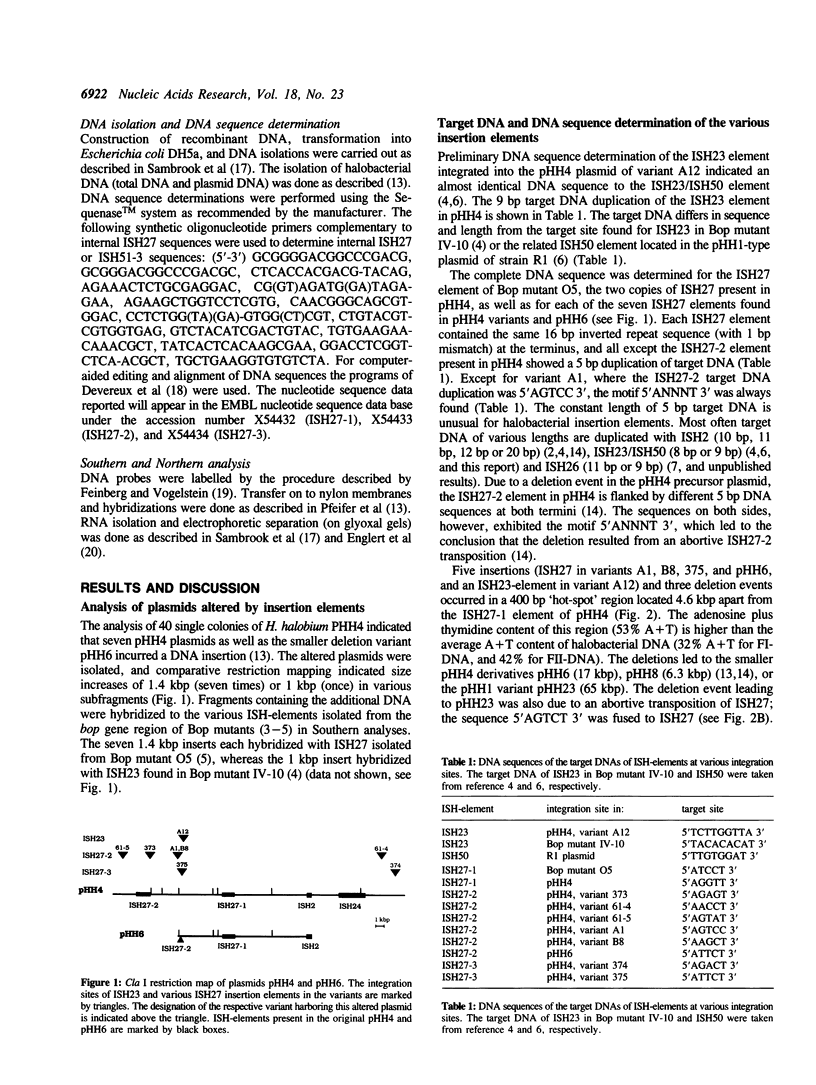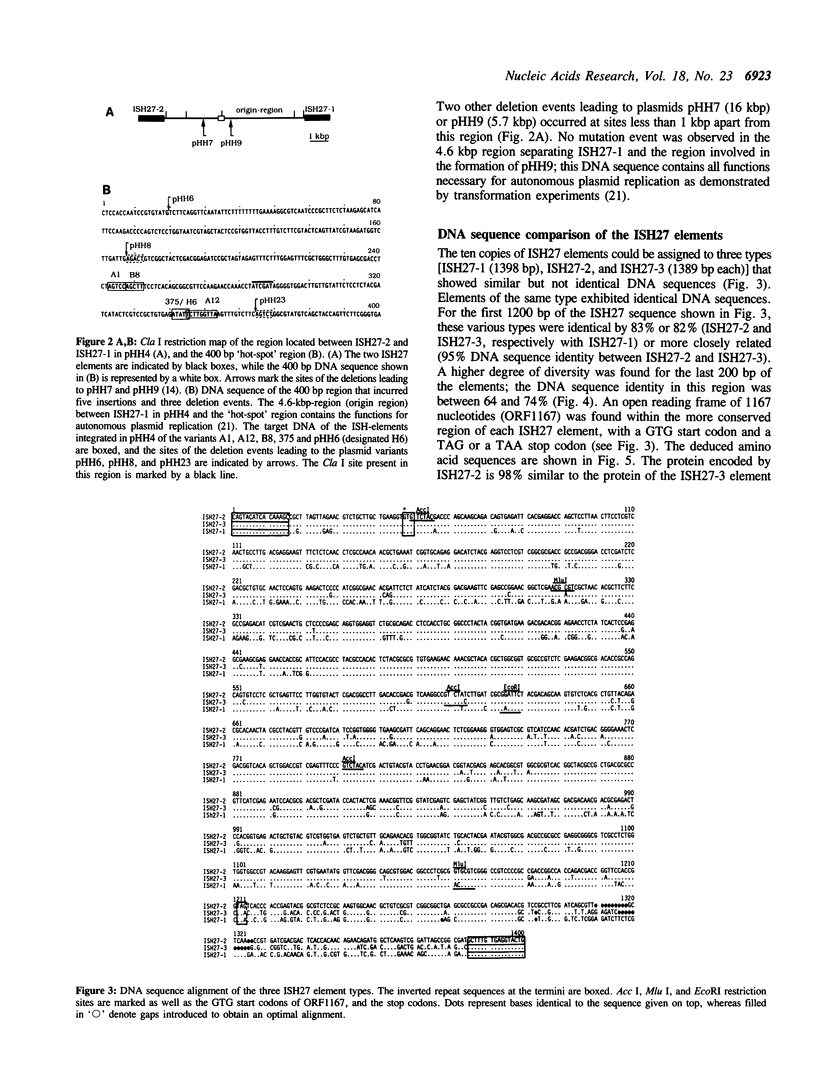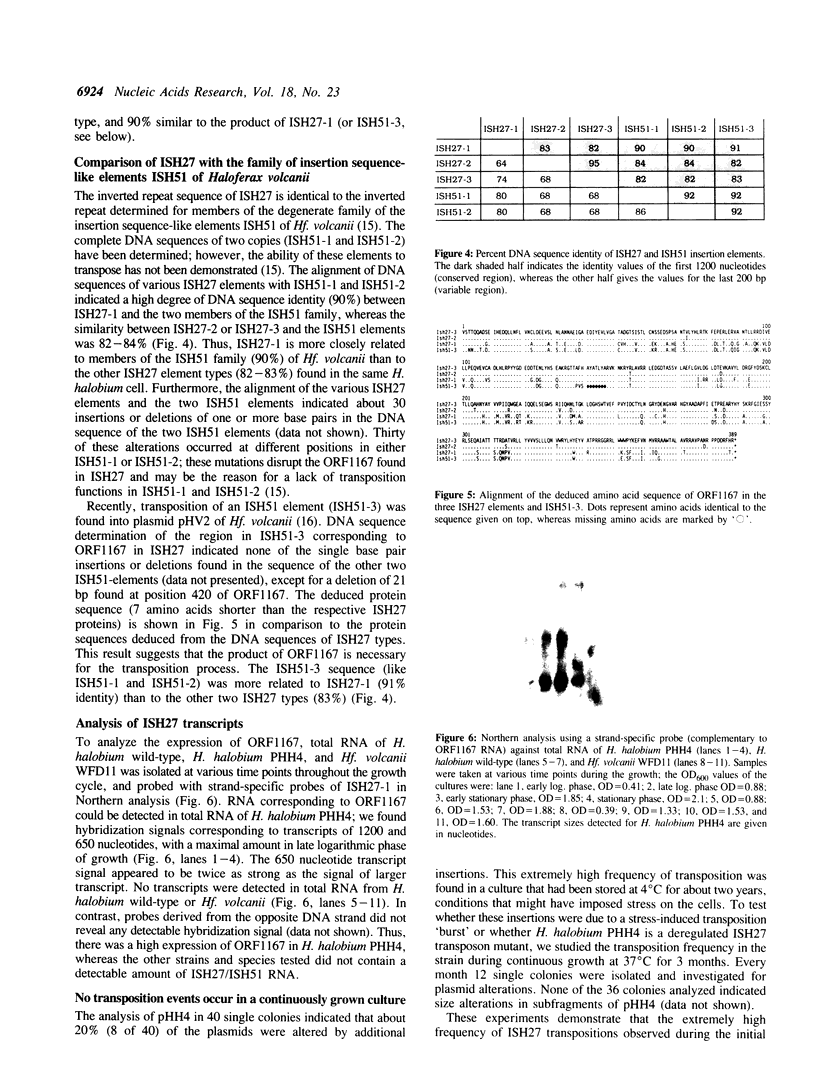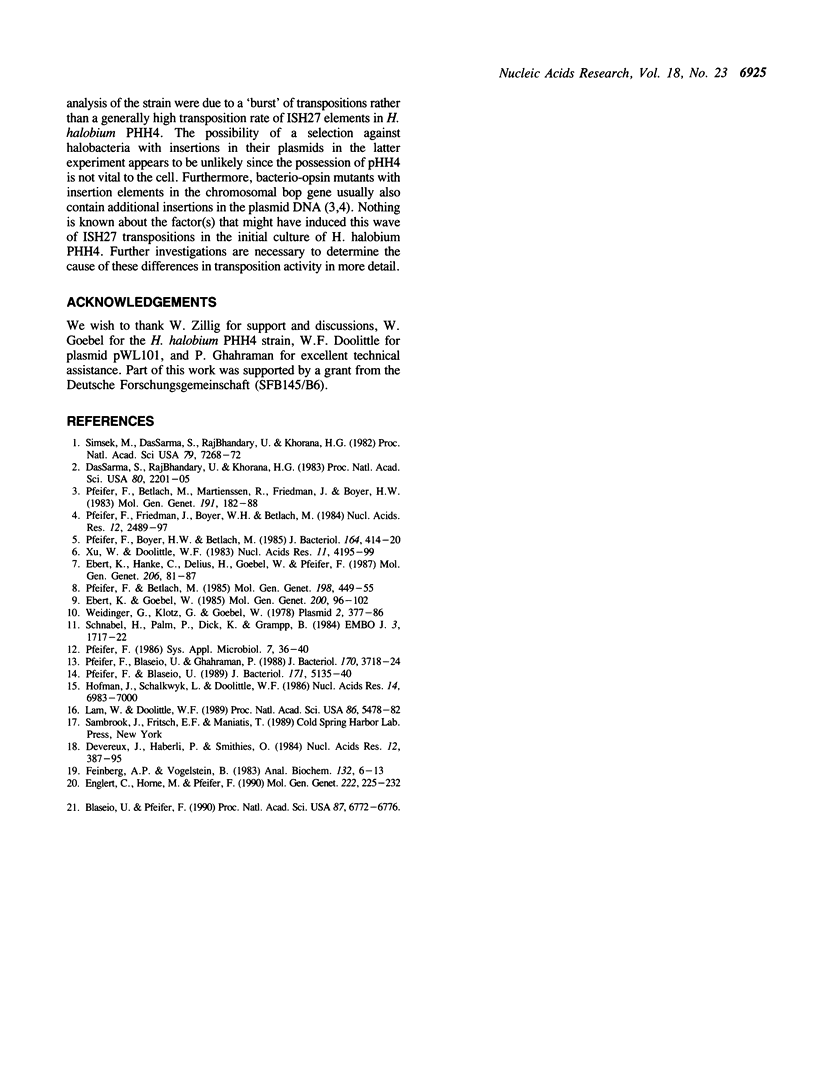Abstract
Investigation of the plasmid pHH4 in single colonies of Halobacterium halobium PHH4 indicated transposition of insertion elements in 20% of the colonies. Seven ISH27 insertions were observed as well as one ISH23 insertion. The various copies of ISH27 were compared to the two ISH27 elements already present in pHH4, and to the ISH27 element that was identified in the bacteriopsin (bop) gene of a Bop mutant. These ten copies of ISH27 constitute three types on the basis of DNA sequence identity: ISH27-1 (1398 bp), ISH27-2, and ISH27-3 (1389 bp each). The DNA sequence comparison between the three types indicates a region of 1200 bp where the identity between ISH27-1 and ISH27-2 or ISH27-3 is 82-83%. ISH27-2 and ISH27-3 are 95% identical in this region. The remaining region exhibits a lower DNA similarity (64-74% identity) between the different copies. An open reading frame of 1167 nucleotides spans the more conserved region, and a corresponding transcript could be detected in H. halobium PHH4, but not in H. halobium wild-type. ISH27-1 is 91% identical to members of the insertion sequence-like elements ISH51 of Haloferax volcanii, whereas the other two ISH27 element types are 82-83% identical to ISH51. The transposition 'burst' of ISH27 was only seen after storage of the cells for more than two years at 4 degrees C. Upon continuous cultivation at 37 degrees C no transposition event could be observed, suggesting that stress factor(s) might have caused the high transposition rate.
Full text
PDF




Images in this article
Selected References
These references are in PubMed. This may not be the complete list of references from this article.
- Blaseio U., Pfeifer F. Transformation of Halobacterium halobium: development of vectors and investigation of gas vesicle synthesis. Proc Natl Acad Sci U S A. 1990 Sep;87(17):6772–6776. doi: 10.1073/pnas.87.17.6772. [DOI] [PMC free article] [PubMed] [Google Scholar]
- DasSarma S., RajBhandary U. L., Khorana H. G. High-frequency spontaneous mutation in the bacterio-opsin gene in Halobacterium halobium is mediated by transposable elements. Proc Natl Acad Sci U S A. 1983 Apr;80(8):2201–2205. doi: 10.1073/pnas.80.8.2201. [DOI] [PMC free article] [PubMed] [Google Scholar]
- Devereux J., Haeberli P., Smithies O. A comprehensive set of sequence analysis programs for the VAX. Nucleic Acids Res. 1984 Jan 11;12(1 Pt 1):387–395. doi: 10.1093/nar/12.1part1.387. [DOI] [PMC free article] [PubMed] [Google Scholar]
- Englert C., Horne M., Pfeifer F. Expression of the major gas vesicle protein gene in the halophilic archaebacterium Haloferax mediterranei is modulated by salt. Mol Gen Genet. 1990 Jul;222(2-3):225–232. doi: 10.1007/BF00633822. [DOI] [PubMed] [Google Scholar]
- Feinberg A. P., Vogelstein B. A technique for radiolabeling DNA restriction endonuclease fragments to high specific activity. Anal Biochem. 1983 Jul 1;132(1):6–13. doi: 10.1016/0003-2697(83)90418-9. [DOI] [PubMed] [Google Scholar]
- Hofman J. D., Schalkwyk L. C., Doolittle W. F. ISH51: a large, degenerate family of insertion sequence-like elements in the genome of the archaebacterium, Halobacterium volcanii. Nucleic Acids Res. 1986 Sep 11;14(17):6983–7000. doi: 10.1093/nar/14.17.6983. [DOI] [PMC free article] [PubMed] [Google Scholar]
- Lam W. L., Doolittle W. F. Shuttle vectors for the archaebacterium Halobacterium volcanii. Proc Natl Acad Sci U S A. 1989 Jul;86(14):5478–5482. doi: 10.1073/pnas.86.14.5478. [DOI] [PMC free article] [PubMed] [Google Scholar]
- Pfeifer F. A., Boyer H. W., Betlach M. C. Restoration of bacterioopsin gene expression in a revertant of Halobacterium halobium. J Bacteriol. 1985 Oct;164(1):414–420. doi: 10.1128/jb.164.1.414-420.1985. [DOI] [PMC free article] [PubMed] [Google Scholar]
- Pfeifer F., Betlach M. Genome organization in Halobacterium halobium: a 70 kb island of more (AT) rich DNA in the chromosome. Mol Gen Genet. 1985;198(3):449–455. doi: 10.1007/BF00332938. [DOI] [PubMed] [Google Scholar]
- Pfeifer F., Blaseio U., Ghahraman P. Dynamic plasmid populations in Halobacterium halobium. J Bacteriol. 1988 Aug;170(8):3718–3724. doi: 10.1128/jb.170.8.3718-3724.1988. [DOI] [PMC free article] [PubMed] [Google Scholar]
- Pfeifer F., Blaseio U. Insertion elements and deletion formation in a halophilic archaebacterium. J Bacteriol. 1989 Sep;171(9):5135–5140. doi: 10.1128/jb.171.9.5135-5140.1989. [DOI] [PMC free article] [PubMed] [Google Scholar]
- Pfeifer F., Friedman J., Boyer H. W., Betlach M. Characterization of insertions affecting the expression of the bacterio-opsin gene in Halobacterium halobium. Nucleic Acids Res. 1984 Mar 12;12(5):2489–2497. doi: 10.1093/nar/12.5.2489. [DOI] [PMC free article] [PubMed] [Google Scholar]
- Schnabel H., Palm P., Dick K., Grampp B. Sequence analysis of the insertion element ISH1.8 and of associated structural changes in the genome of phage PhiH of the archaebacterium Halobacterium halobium. EMBO J. 1984 Aug;3(8):1717–1722. doi: 10.1002/j.1460-2075.1984.tb02037.x. [DOI] [PMC free article] [PubMed] [Google Scholar]
- Simsek M., DasSarma S., RajBhandary U. L., Khorana H. G. A transposable element from Halobacterium halobium which inactivates the bacteriorhodopsin gene. Proc Natl Acad Sci U S A. 1982 Dec;79(23):7268–7272. doi: 10.1073/pnas.79.23.7268. [DOI] [PMC free article] [PubMed] [Google Scholar]
- Weidinger G., Klotz G., Goebel W. A large plasmid from Halobacterium halobium carrying genetic information for gas vacuole formation. Plasmid. 1979 Jul;2(3):377–386. doi: 10.1016/0147-619x(79)90021-0. [DOI] [PubMed] [Google Scholar]
- Xu W. L., Doolittle W. F. Structure of the archaebacterial transposable element ISH50. Nucleic Acids Res. 1983 Jun 25;11(12):4195–4199. doi: 10.1093/nar/11.12.4195. [DOI] [PMC free article] [PubMed] [Google Scholar]



